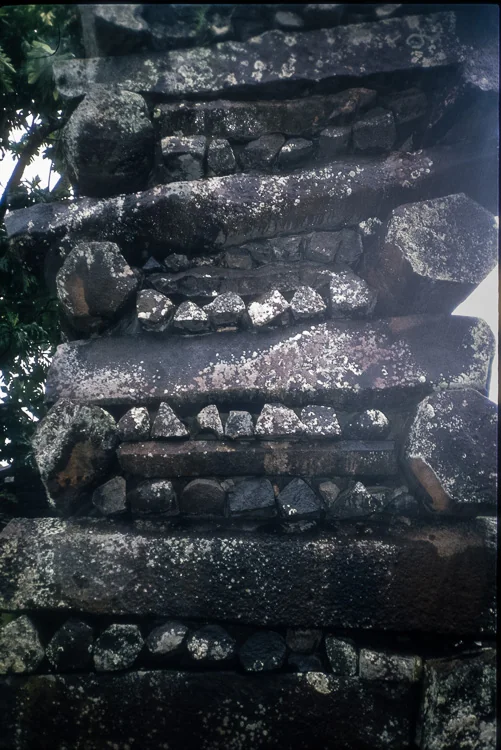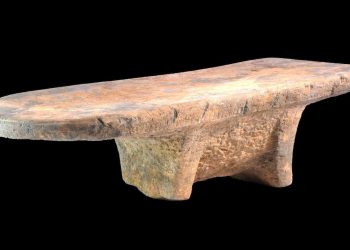From the shoreline of Pohnpei, dark stone walls rise from the lagoon like the ribs of a drowned city. The ancient artificial island in Micronesia, known as Nan Madol, stretches across the reef in a maze of basalt islets, shaped and stacked by hand.
The ruins were built without mortar, without cranes, and without written plans. Volcanic stones, quarried from elsewhere on the island, were transported across jungle and water, then arranged into tombs, temples, and ceremonial platforms.
No one knows exactly how the builders moved such massive blocks, or what methods they used to fit them so tightly. The reasons for the city’s abandonment are also unclear, though oral traditions speak of conflict, overreach, and collapse. What remains is a quiet skeleton of basalt, exposed to tide and rain, and still holding together after centuries in the sea.
A city on the sea
Nan Madol is not a single island but a complex of approximately 92 artificial islets, constructed atop a coral reef off the southeastern shore of Pohnpei. These islets are separated by tidal canals and encased in high basalt walls, forming a checkerboard of walkways, courtyards, and enclosures. From above, it resembles an ancient city frozen in time.
Spanning roughly 1.5 kilometers in length and 0.5 kilometers in width, the layout is intentional. The islets are organized by function: some designated for rituals, others for burial, and a few reserved for ruling elites. The walls rise directly from the sea, with some reaching heights of over 7 meters, creating narrow corridors between water and stone.
Moving across the site today involves stepping across slippery rock platforms and navigating brackish pools. While some structures remain intact, others have crumbled into moss-covered ruins. The tidal canals ebb and flow, softening edges and nourishing encroaching vegetation. Despite its monumental construction, the site exudes an atmosphere of abandonment, shaped by centuries of exposure to natural elements.

The mystery of the megaliths
Most of the structures at Nan Madol were constructed using columnar basalt, a volcanic rock that naturally forms into long, hexagonal columns. These basalt columns, some weighing several tons, were quarried from sites on the main island of Pohnpei, including areas such as Sokehs on the opposite side of the island . Transporting these massive stones would have involved traversing challenging terrain, dense jungle, and open water.
The Pohnpeians did not have wheeled vehicles or draft animals. There is no definitive evidence detailing the exact methods used to move and position the basalt columns. The builders left behind no written records, tools, or construction plans.
The walls were constructed without the use of mortar. Basalt pieces were meticulously stacked in alternating layers, interlocking similarly to timber construction. At certain junctions, massive cornerstones were employed to tie the structures together with precise angles. Some outer walls are up to five meters thick, with interior spaces lined by additional stone to create tombs, altars, and raised platforms.
Oral histories from Pohnpei recount tales of sorcery. One legend speaks of twin brothers from a distant land who summoned the stones into place through chants. Other stories describe the stones being floated on rafts. Modern hypotheses suggest the use of rollers, levers, or rafts timed with tides. However, none of these theories fully explain the logistics involved, especially concerning the heaviest stones and the precision observed in the construction.
Ritual, royalty, and power
Archaeological studies suggest that Nan Madol served as the ceremonial and political center of the Saudeleur dynasty, which ruled Pohnpei from around the 12th to the early 17th century. The complex was not a residence for the general population. Only priests, rulers, and their attendants lived within its walls.
At the heart of the site is Nandauwas, a high-walled compound thought to be the royal mortuary. Its inner chambers are surrounded by massive basalt enclosures. Excavations there have revealed burial sites and ceremonial artifacts, although most material culture has been lost to time and salt.
The city’s isolation and structure enforced hierarchy. Commoners were required to bring offerings by canoe but could not set foot on the islets. The ruling class used the site to consolidate religious authority and political control. Rituals involving ancestor worship, navigation, and agriculture likely took place on raised stone platforms now overgrown or submerged.
The decline of Nan Madol likely came from within. Oral accounts describe increasing authoritarianism, heavy tribute demands, and social unrest. By the time European ships reached Pohnpei in the early 1800s, the city had long been abandoned.
An origin story no one agrees on
Nan Madol was constructed without the use of a written language. There are no known stelae, codices, or symbols carved into its basalt structures. Our understanding of the site derives from oral traditions, archaeological investigations, and the physical remnants themselves
Radiocarbon and uranium-thorium dating indicate that significant construction at Nan Madol began around 1180 CE. Earlier occupation of the area likely dates back several centuries, with human activity on Pohnpei traced to as early as 80–200 CE.
The development of Nan Madol occurred in phases. Initial islets served as basic platforms, which were subsequently expanded into more formal structures. Over generations, additional stones were added, walls were raised, and the ceremonial core of the complex was extended.
Some scholars have proposed that influences from Southeast Asia may have contributed to the site’s design. However, others argue for entirely local innovation, emphasizing Pohnpei’s advanced navigation skills, oral culture, and sacred geography. To date, no definitive connections to external cultures have been established.
What is evident is that the builders possessed a profound understanding of their environment. They constructed the city atop a coral reef capable of supporting the weight of basalt, strategically placed structures to withstand tidal forces, and employed interlocking stone techniques that have endured centuries of exposure.
The importance of Nan Madol
Few ancient cities were ever built on top of a coral reef. Nan Madol is one of them. Its foundations rest on living coral, just off the coast of Pohnpei, far from any mainland or trade center. Stone by stone, it was raised in the water, not on land. That alone makes it different. To, me that alone makes this site so extraordinary.
Because let’s face it, building anything in the sea is difficult. Building with volcanic stone, some of it weighing several tons, is harder still. The basalt had to be moved, shaped, and placed with precision. The people who built Nan Madol did that work without mortar, without cranes, and without metal tools. The city’s layout wasn’t improvised. It took planning, effort, and organization, the kind of work that comes from a centralized authority directing labor over time.
UNESCO added Nan Madol to its World Heritage list in 2016. That helped bring attention to how vulnerable the site is. Parts of it are already sinking. Sea level rise and saltwater erosion are breaking down the walls. Mangrove roots creep between the stones, shifting what was once stable.
The site isn’t easy to visit. Pohnpei sits far off the usual routes. There’s no tourist center, no marked paths, no preservation infrastructure in place. Most of what archaeologists know comes from limited fieldwork and old reports. Much of the site remains untouched.
There are no guides waiting at the edge of the ruins. No signs to explain what you’re looking at. Just stone walls, thick and dark, sitting in the tide. Some have collapsed. Others still stand exactly where they were placed, more than eight centuries ago. The builders left no writing behind. No explanation. Only basalt stacked on coral, holding on as long as it can.











